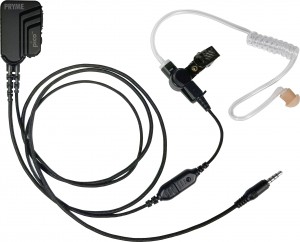Communications advancement marches forward

FirstNet the future of critical communications is riding on this network. Traditionally first responders are LMR (Land Mobile Radio) users, however it’s clear the transition to LTE cellular is on the horizon.A communications app developer recently described smartphones as a “shadow IP” that almost every employee in the U.S. has access to, yet not all businesses take advantage of (though PTT over cellular or PoC multi-functionality is fast replacing LMR in the commercial sector.)
Luckily for public safety, FirstNet’s nationwide broadband network provides a serious leg-up in advancement but, I believe devices that do more than just talk will be the primary driver of its evolution, says Dave George, chief engineer and president of Pryme Radio.
One small, but easily surmountable hurdle is that agencies require more robust PTT cellular devices than standard smart phones. Over the next few years, I’m sure there will be a major bump in FirstNet-geared hardware development for first responders.
But, the growing desire to aggregate tasks into one device in both private and public sectors is creating an even bigger window for software. Consequently, I foresee IoT/LTE business will be accelerated more by application development than by hardware.
To illustrate my point, visualise an officer who has a body cam (or multiple cams) connected via fiber optic cable to a new ruggedised wireless device designed specifically for Police use, which accesses a video management app, plus another app for location tracking, and another for facial recognition, or maybe just one “super app” that ties them all together for “Bad Guy” recognition, as well as automatic photo/video with time, location, etc. Apps, apps, apps—Clearly the opportunities are endless!
Apps on steroids
As a technologist, it’s my opinion that agencies will soon be able to receive much more tactical/situational information from all active incidents, including verbal transmissions, without ever touching a communications device.
Why couldn’t this new device have an app that knows when an officer’s been dispatched, when to automatically trigger the camera, send alerts (i.e. shots fired, man-down, etc.), enable microphone and exchange messages, all while monitoring every movement even if they leave the vehicle or draw a weapon? It would be like Siri or Alexa on steroids.
If app sophistication continues advancing at light speed, even for public safety users, the voice function could potentially become a much lower-priority than data that supports a plethora of new capabilities, And some of these same apps might also include messaging, creating a simultaneous communications loop.
The entire world now uses cell phones for data more than voice, so why should we expect first responders to be any different? Of course, public safety requires “rock solid” technology, but developers are rising to the challenge! Meanwhile public transportation, hospitality, field services, professionals and other users from across many vertical markets are already starting to deploy PoC applications.
We’ve seen evidence everywhere, such as in hotel management, where radio communications once managed by the maintenance department, are being replaced by such smart devices as iPod Touches with PoC apps, and are now tied to property management computer networks run by the IT Department. This is a clear indicator of sophisticated adaptation and the evolution of technology.
PTT/PoC IoT growth
Cellular market growth has created an almost insatiable demand for all sorts of new products and accessories in a wide range of industries. Pryme has seen a 30% jump in PTT products for smart devices with PoC applications, and there’s no end in sight. We already support 28 different PTT apps, and our full line currently spans 5500 unique products. The more applications developed, the more devices deployed, which means the greater the need for end-user customisation, an area where Pryme excels.
For example, because some users find wireless PTT unacceptable due to cost, pairing and charging issues, someone needed to develop an alternative to access PoC applications on smart devices. Wired accessories are typically more reliable, but wouldn’t work because many cell phones and tablets were not designed for PTT.
Though it took a couple years, Pryme managed to engineer a workaround and, at IWCE 2018, introduced the PICO wired surveillance kit, a new way to dependably manage PTT capabilities and PoC apps with a wired accessory, but without any of the aforementioned wireless issues. However wireless is still very useful and I envision future technologies that will result in better and better wireless accessories. Pryme is already starting to add Near Field Pairing (NFC), which automatically connects headsets/PTT buttons to phones or tablets.
Proliferating smart tech
Every minute of the day, smart technologies such as AR/VR and AI, are being incorporated into more communications solutions for an array of niche uses. With augmented reality, instead of traveling to trade shows or customers, sales reps will be able to share a link to a 360° experience(s) of their products and demos.
In field services, AR is already starting to proliferate. Simply by pointing a smartphone at a machine, a technician can receive training and repair instructions superimposed over the image on the machine. And artificial intelligence is spreading like wildfire in a multitude of ways, including serving as a 24/7 watchdog to identify potential system issues before they become problems. Who knows, eventually smart tech may completely change the way first responders operate. All we need in that “Killer App.”
The national network pie
The arrival of FirstNet’s nationwide network has opened up a huge market opportunity, which could prompt mega monoliths like Honeywell, General Dynamics, Boeing, etc. to enter the public safety communications space with new sector specific devices.
 Until now, I think these huge conglomerates viewed the two-way radio industry as too small and fragmented to even consider. Now that the market opportunity is nationwide and will become more standards based, don’t be surprised if you see major new competitors entering this playing field.
Until now, I think these huge conglomerates viewed the two-way radio industry as too small and fragmented to even consider. Now that the market opportunity is nationwide and will become more standards based, don’t be surprised if you see major new competitors entering this playing field.
For these really big companies, the design, installation and maintenance of networks is where the real profits lie and FirstNet is a network opportunity that includes many valuable features. Yet, for this network to be successful, technologies must be adopted that provide the key features high priority users require: reliability, security, low latency, device-to-device and group calling, talker ID, and so on.
In addition, more progressive capabilities must be offered, such as location and data services, interconnection with legacy systems, console interfaces and, lest we forget, more specialised apps.
Will there be bumps in the broadband road along the way? Sure. Will those issues be resolved? Absolutely. Remember, without roads, we have no cars, and without a powerful yet affordable wireless network, there will be no advanced communications. Hang on tight, it’s going to be a heck of a ride!
The author of this blog is Dave George, chief engineer and president of Pryme Radio
Comment on this article below or via Twitter @IoTGN
